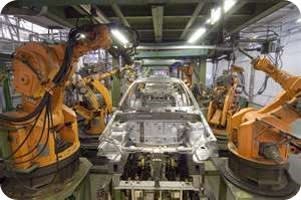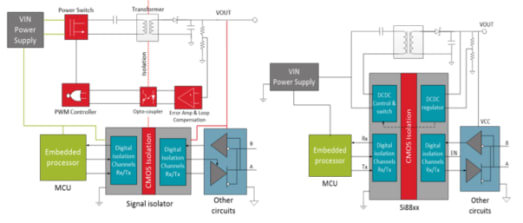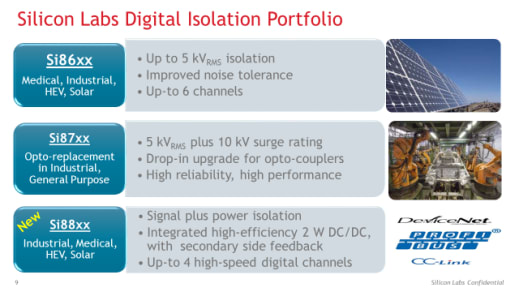Industrial Digital Isolator Integrates Signal plus Power Isolation
Follow articleHow do you feel about this article? Help us to provide better content for you.
Thank you! Your feedback has been received.
There was a problem submitting your feedback, please try again later.
What do you think of this article?
Introduction - Industrial Design Challenges
Industrial designs perform complex control and high-power delivery in noisy environments. Industrial designs utilize low-voltage (3-5Vdc) digital embedded microcontrollers to control high-power drive circuity (>24V), with wired and wireless operator control interfaces to automate industrial apparatus and machinery in a safe and power efficient system. Digital control MCU circuits running field-oriented control (FOC) software algorithms for variable-frequency drive (VFD) interface to inverter power circuits to control power delivery of multiphase 400VAC to drive induction motors. Operator safety from high-voltage hazards, common-mode system ground loops, and 5KV circuit immunity from power switching EMI noise are challenging design issues that industrial designs must eliminate. These are just a few of the complex design challenges facing designers of industrial control and automation systems.
Industrial designs utilize electrical isolation components to suppress and eliminate these industrial environment issues. Isolation design techniques provide 3 main circuit functions:
- Safety from high voltages – to allow signal transfer across a very high common mode voltage between GND1 and GND2.
- Level shifting – between voltage supplies of different magnitudes, like 24V to 5V or 2.7V to 5V.
- Noise reduction – isolators prevent ground noise from one circuit from contaminating measurements in the adjacent circuit.
Isolation component technology is available in several following forms: Transformer (galvanic), Optocoupler (lightwave) and Capacitive (CMOS semiconductor). One method of isolating a control system's low-voltage circuitry from the potentially dangerous high-voltages of the sensor and actuator sections is by using digital isolators. Digital isolators come in single, dual, or quad channel form that utilize 3V or 5V logic switching thresholds that isolate digital single-ended data lines at up to 100 Mbps data rates. This article will focus on CMOS capacitive isolator components in industrial circuit applications.
CMOS Capacitive Isolation Construction
The basic operating principle of the CMOS digital isolator is similar to that of an optocoupler. In a CMOS digital isolator the output logic state control is determined by the presence or absence of a high-frequency (HF) carrier instead of light in an optocoupler. The isolator output state is determined by either an input logic level or an input current, similar to the optocoupler.
Figure 1. CMOS Digital Isolator Construction
The heart of any digital isolator is the isolation barrier that safely withstands the applied high-voltage stress. The optocoupler isolation barrier relies on a combination of a physical gap (i.e., distance through insulator or DTI); polyimide tape, silicon filler and plastic mold compound for insulation (see Figure 1). This hybrid methodology not only makes increased optocoupler integration difficult, but increases fabrication complexity and thus cost and reliability. International standards specify isolation barrier requirements based on optocoupler DTI. All the standards agencies tests are based on barrier withstand voltage regardless of device implementation.
CMOS construction and careful attention to design enable CMOS digital isolators to achieve higher degrees of performance, reliability and ease-of-use, primarily by virtue of these key enabling technologies:
- Mainstream, low-power CMOS process technology is utilized instead of GaAs: CMOS is the highest performance, most reliable and cost-effective process technology available. Devices fabricated in CMOS exhibit superior timing, integration, operating stability and reliability characteristics compared to gallium arsenide processes used in optocouplers.
- High-frequency carrier modulation instead of light: The combination of the precision, high-frequency carrier and narrow receiver pass band provides tight frequency discrimination for outstanding noise rejection and thus higher data integrity.
- Fully differential isolation path instead of single-ended: Optocouplers are single-ended devices and are subject to CMT perturbations. The differential signal path and high receiver selectivity of CMOS digital isolators provides high rejection of common-mode transients up to 50 kV/µS, external RF field immunity as high as 300 V/m and magnetic field immunity beyond 1000 A/m.
- Proprietary EMI design techniques: CMOS digital isolators meet the FCC Part B emission standards for conducted and radiated EMI. For more information on CMOS isolator emissions, susceptibility and reliability vs. optocouplers, see the Silicon Labs white paper, “CMOS Isolators Supersede Optocouplers in Industrial Applications”.
Signal Isolation and Integrated DC/DC Power Isolation
Power is required on both the primary and secondary side of the isolation barrier. Digital isolators solve these problems by providing signal and power supply isolation.
Figure 2. Control system Digital Isolator provides signal and power isolation
In the figure 2, the control room diagram on the left is connected to factory floor through a hierarchical system. These systems are deployed in industrial automation to connect sensors and actuators that are spread out over distances across the factory floor. This forms the physical layer for the automation scheme. In the figure, a CAN bus is shown for connecting the motor Drive units while a ProfiBus is shown to connect the machines. Each node of the CAN bus is a CAN transceiver while ProfiBus uses RS-485 transceivers. These transceivers receive and transmit data over the bus. There could be as many as 256 nodes per network. Each one of them needs to be isolated with a 2 or 3 channel isolator as shown in the figure on the right. The transceiver and the secondary side of the isolator need a little less than 1W of isolated power. Digital isolators can integrate the DC/DC PWM controller and switch to provide secondary-side power to the power regulator using a flyback circuit in circuit, pictured on the right side in Figure 2. The Silicon Labs Si88xx digital isolator family is a good solution for isolating RS-485, CAN and RS-232 data signals and powering the transceivers across the isolation barrier in industrial communication circuits.
Figure 3. Left - Discrete External DC/DC Power vs. Right - Digital Isolator Integrated DC/DC Power
Isolated power is necessary for an industrial communications bus. In Figure 3, the diagram on the left shows the isolated power discrete circuit which requires several components to power the secondary-side components. Power design expertise in switch node layout and control loop tuning is required.
The Si88xx digital isolator circuit shown on the right in Figure 3 solves this problem by providing a space saving integrated DC/DC controller requiring just a few external components to power the isolated communications bus. The Si88xx family can provide up to 5 watts with an external switch that can power the transceiver and other secondary-side components.
Figure 4 – Si88240 Digital Isolator diagram
The Si88xx delivers all the advantages of CMOS digital isolators like low propagation delay and skew, 5kVrms ratings, and flexible channel configurations. The Si88xx family offers a very high CMTI of 100kV/µs under typical conditions. In figure 4, the Si88240 converter shows a modified flyback topology with integrated FET switches (labelled VSW in diagram) that modulates power to an external transformer (UTB02185).The Si88xx is a multi-channel isolator with a 2W power capable integrated DCDC converter that achieves 78% efficiency. The Si88xx has additional noise and efficiency features such as frequency dithering for low EMI, ZVS for minimizing power loss, and Soft start, frequency control and shutdown.
Silicon Labs offers digital isolators with parametric features for industrial markets and applications. The Si86xx family is the most flexible for digital isolator solutions. From single channel to six channels, and from compact QSOP packages to wide body packages that can handle the creepage distances required by high voltage applications and the functional 1kV to 5kV rated isolation for industrial and medical grade products.
The Si87xx is a specialized product family that is designed to replace optocouplers. The Si87xx parts are pin to pin replacements so the designers do not have to change their PCB design. The Si87xx digital isolators provide optocoupler pin compatibility, along with improved performance and reliability.
New Si88xx IsoVolt combines the functionality of the Si86xx and adds an isolated DC/DC power solution.
For more information on Silicon Labs Digital Isolators visit RS Components;







